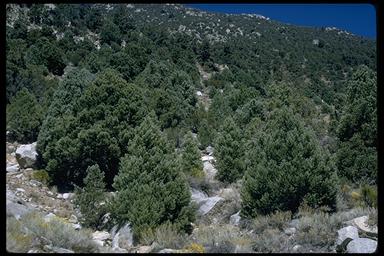

Singleleaf
Piņon Pine
Pinus monophylla
 |
 |
|
An arborescent, woody perennial that can be found throughout western North America. Often found in rocky soil. Elevation range extends from sea level to over 2700 meters. In the southwestern United States, small piņon pines may grow at the base of mountains. Pine trees in general can tolerate drought but require full sunlight and clean air for good growth and reproduction. Pines have two types of branches, long shoots and short shoots, and three types of leaves, primordial, scale, and adult. Pines are softwoods, but commercially they may be designated as soft pines or hard pines. Soft pines, such as white, sugar, and piņon pines, have relatively soft timber, needles in bundles of five (rarely, one to four), stalked cones with scales lacking prickles, and little resin. Their wood is close-grained, with thin, nearly white sapwood; the sheaths of the leaf clusters are deciduous, and the leaves contain a single fibrovascular bundle. Hard pines, such as Scots, Corsican, and loblolly pines, have relatively hard timber, needles in bundles of two or three (rarely, five to eight), cone scales with prickles, and large amounts of resin. Their wood is coarse-grained and usually dark-coloured, with pale, often thick sapwood; the sheaths of the leaf clusters are persistent, and the leaves have two fibrovascular bundles. The chief value of pines is in the construction and paper-products industries, but they are also sources of turpentine, rosin, oils, and wood tars (naval stores); longleaf, slash, cluster, and Chir pines are cut for these materials. Charcoal, lampblack, and fuel gases are distillation by-products. Pine-leaf oil, used medicinally, is a distillation product of the leaves. Edible pine seeds are sold commercially as pine nuts, piņons, or pignons, produced by stone, Armand, Siberian, piņon, Torrey, Coulter, and digger pines. Pines are susceptible to several fungal diseases, among them white-pine blister rust, and are attacked by many insects, such as sawflies, weevils, bark beetles, and tip moths. Pine forests often suffer severe fire damage, being very combustible because of their high resin content. Many pines have both lumber trade names and several common names. Numerous trees commonly called pines are not true pines but belong to other genera in the family Pinaceae or to other families of conifers. Portions copyright 1994-1998 Encyclopaedia Britannica |